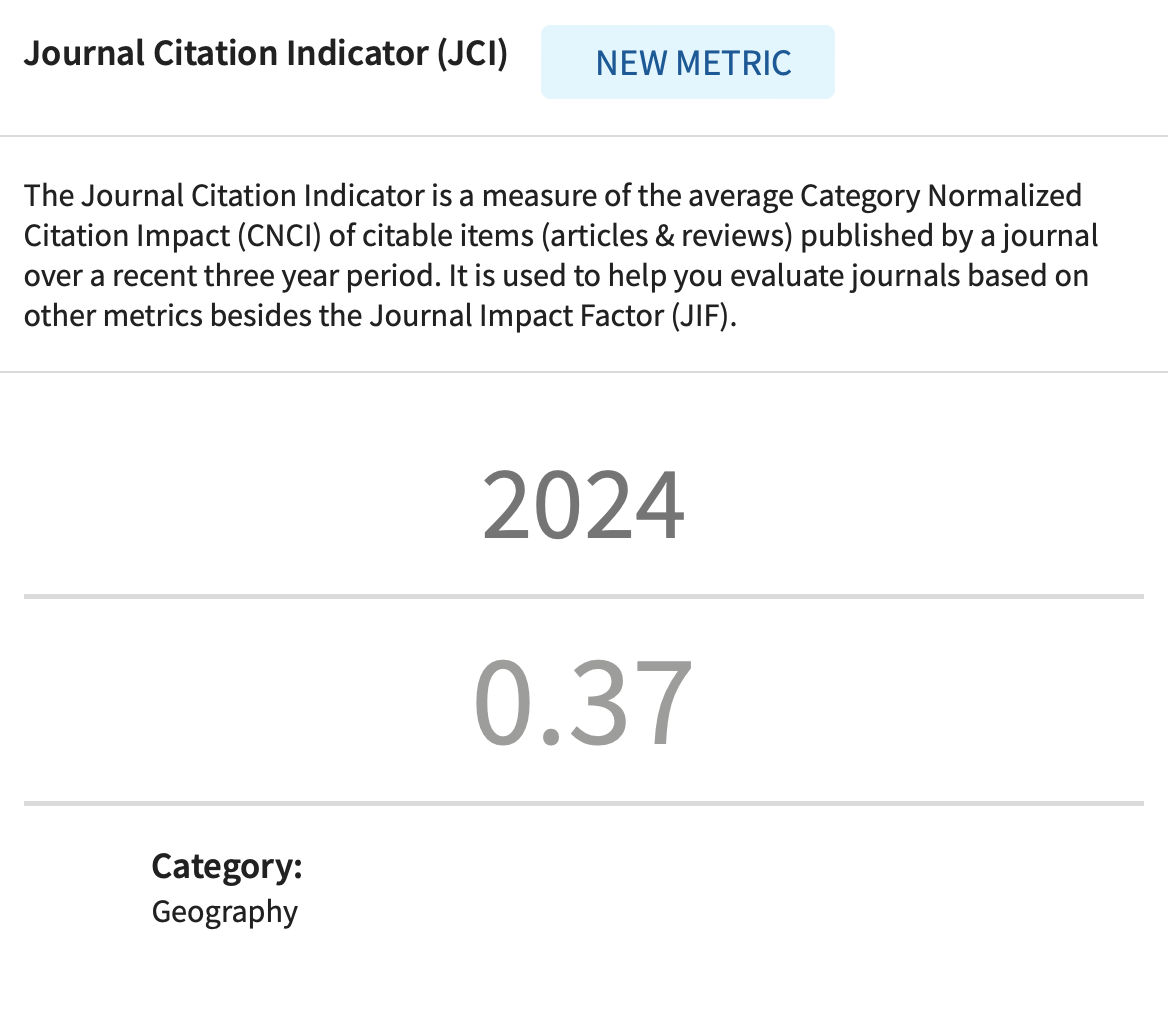FEMALE SENIOR ONE-PERSON HOUSEHOLDS IN MALAGA MUNICIPALITY (SPAIN). TEMPORAL EVOLUTION AND INTRAURBAN SPATIAL DISTRIBUTION
DOI:
https://doi.org/10.2298/IJGI240729016BKeywords:
solo-living, senior females, neighborhood, spatiotemporal analysis, Malaga (Spain)Abstract
The number of senior women (age 75 and over) living alone has multiplied notably in the municipality of Malaga. This population group can be considered as vulnerable, since living alone may have consequences on both physical and mental health. In this research, it is accounted, firstly, on the numerical evolution of this type of household in the municipality of Malaga, based on the data from the municipal register of inhabitants. Secondly, their intraurban spatial distribution, using the Location Quotient (LQ) for this was investigated. Results indicate, on the one hand, that effectively this type of household has increased remarkably, in proportion more than the total of senior women has. On the other hand, their spatial distribution in Malaga urban tissue is not homogeneous, and the neighborhoods with overrepresentation can be largely identified with the older ones. In this regard, the identification of clusters of neighborhoods where these households are overrepresented may be useful for planning within the context of ageing in place.
Article metrics
References
Abad Romero, P., & Rodríguez Míguez, E. (2002). Características socioeconómicas y estructura de los hogares de las personas mayores en España [Socioeconomic characteristics and structure of the homes of older people in Spain]. Hacienda Pública Española / Revista de Economía Pública, 161, 49– 68. https://econpapers.repec.org/article/hpejournl/y_3a2002_3av_3a161_3ai_3a2_3ap_3a49-68.htm
Delgado Urrecho, J. M., & Martínez Fernández, L. C. (2019). Composición y cambio de los comportamientos sociodemográficos en España en los inicios de una Segunda Transición Demográfica [Composition and change of sociodemographic behaviors in Spain at the beginning of a Second Demographic Transition]. Cuadernos Geográficos, 58(1), 253–276. http://dx.doi.org/10.30827/cuadgeo.v58i1.6750
Dykstra, P. A. (2021). Living arrangements in later life. In N. F. Scheider & M. Kreyenfeld (Eds.), Research handbook on the sociology of the family (pp. 205–217). Edward Elgar Publishing.
Espinosa Almendro, J. M., Muñoz Cobos, F., & Portillo Stermpel, J. (2005). Clasificando a las personas mayores. Una visión dinámica [Classifying older people. A dynamic vision]. Medicina de Familia (And), 6(3), 167–168. https://drarturogeriatria.wordpress.com/wp-content/uploads/2018/08/clasific-ama.pdf
Esteve, A., Reher, D. S., Treviño, R., Zueras, P., & Turu, A. (2020). Living alone over the life course: cross-national variations on an emerging issue. Population and Development Review, 46(1), 169–189. http://dx.doi.org/10.1111/padr.12311
Esteve, A., Pohl, M., Becca, F., Fang, H., Galeano, J., García-Román, J., Reher, D., Trias-Prats, R., & Turu, A. (2024). A global perspective on household size and composition, 1970-2020. Genus, 80(2). http://dx.doi.org/10.1186/s41118-024-00211-6
García Pulgarín, L. V., & García Ortiz, L. H. (2005). El adulto mayor maduro: condiciones actuales de vida [The mature older adult: current living conditions]. Revista Médica de Risaralda, 11(2), 1–8. https://dialnet.unirioja.es/descarga/articulo/5030408.pdf
Henning-Smith, C., & Gonzales, G. (2020). The relationship between living alone and self-rated health varies by age: evidence from the National Health Interview Survey. Journal of Applied Gerontology, 39(9), 971–980. https://doi.org/10.1177/0733464819835113
Instituto Nacional de Estadística. (2001). Definiciones censales básicas [Basic census definitions]. https://www.ine.es/censo2001/6.pdf
Insituto Nacional de Estadística. (2021). Encuesta continua de hogares (ECH) 2020 [Continuous household survey (CHS) 2020]. https://www.ine.es/prensa/ech_2020.pdf
Instituto Nacional de Estadística. (2023). Censo Nacional de Población y Viviendas, 2021 [National Population and Housing Census, 2021]. [Data set]. https://www.ine.es/Censo2021/Inicio.do?L=0
Jordá Borrel, R., & Lucendo Monedero, A. L. (1996). Georreferenciación y caracterización de la población anciana en la ciudad de Sevilla [Georeferencing and characterization of the elderly population in the city of Seville]. In I. Moro & J. Juaristi Linacero (Eds.), Modelos y Sistemas de Información en Geografía: Actas del VII Coloquio de Geografía Cuantitativa, Sig y Teledetección [Models and Information Systems in Geography: Proceedings of the VII Colloquium on Quantitative Geography, GIS and Remote Sensing] (pp. 405–412). Universidad del País Vasco. https://idus.us.es/server/api/core/bitstreams/861fa3eb-d254-4349-8686-c0c1dcc6f545/content
Laparra Navarro, M. (2010). El impacto de la crisis en la cohesión social o el surf de los hogares españoles en el modelo de integración de la sociedad líquida [The impact of the crisis on social cohesion or the surf of Spanish households in the integration model of the liquid society]. Documentación social, 158, 97–130. https://www.caritasvitoria.org/datos/documentos/ponencia_topaki2010.pdf
Lázaro Ruiz, V., & Gil López, A. (2005). La calidad de las viviendas de los ancianos y sus preferencias ante la institucionalización [The quality of old people’s housing and their preferences before institutionalisation]. Intervención Psicosocial, 14(1), 21–40. https://journals.copmadrid.org/pi/archivos/94935.pdf
Lesthaeghe, R., & Van de Kaa, D. J. (1986). Twee demografische transities? Bevolking: groei en krimp. Van Loghum Slaterus.
Lesthaeghe, R. (2014). The second demographic transition: A concise overview or its development. PNAS, 111(51), 18112–18115. https://doi.org/10.1073/pnas.1420441111
Lesthaeghe, R. (2020). The second demographic transition, 1986-2020: sub-replacement fertility and rising cohabitation- a global update. Genus, 76, 10. https://doi.org/10.1186/s41118-020-00077-4
Liu, C., & Esteve, A. (2021). Living arrangments across households in Europe. In N. F. Scheider & M. Kreyenfeld (Eds.), Research handbook on the sociology of the family (pp. 187–247). Edward Elgar Publishing.
López Jiménez, J. .J. (1991). Estructura y diferenciación espacial de la población anciana en el municipio de Madrid [Structure and spatial differentiation of the elderly population in the municipality of Madrid]. Espacio, Tiempo y Forma, Serie VI, Geografía, IV. 217–252. http://e-spacio.uned.es/fez/eserv/bibliuned:ETFSerie6-75A2DBD6-E4FB-E847-52CD-5269D600E84C/Documento.pdf
López Jiménez, J. J., & Renes Ayala, V. (2011). Los efectos de la crisis en los hogares: nivel de integración y exclusión social [The effects of the crisis on households: level of integration and social exclusion]. Papeles de relaciones ecosociales y cambio global, 113, 189–199. http://revistas.uned.es/index.php/ETFVI/article/view/2491
López Villanueva, C., & Pujadas Rúbies, I. (2018) Vivir solo en España. Evolución y características de los hogares unipersonales en la vejez [Living alone in Spain. Evolution and characteristics of single-person households in old age]. Panorama Social, 28, 93–115. https://www.funcas.es/wp-content/uploads/Migracion/Articulos/FUNCAS_PS/028art05.pdf
López Villanueva, C., Pujadas Rúbies, I., & Rubiales Pérez, M. (2019). Hogares unipersonales y curso de vida: diversificación por edades y concentración espacial en las regiones urbanas de Madrid y Barcelona [Single-person households and life course: diversification by age and spatial concentration in the urban regions of Madrid and Barcelona]. Estudios Geográficos, 80(287), e012. https://doi.org/10.3989/estgeogr.201929.009
López López, M. T., Sánchez Fuentes, A. J., & González Hincapié, V. (2019). Desigualdades atendiendo a las capacidades, composición y economía de los hogares españoles [Inequalities based on the capabilities, composition and economy of Spanish households]. FOESSA. https://www.foessa.es/main-files/uploads/sites/16/2019/05/1.5.pdf
Ministerio de Sanidad, Política Social e Igualdad. (2011). Libro blanco sobre el envejecimiento activo [White paper on active aging]. Ministerio de Sanidad, Política Social e Igualdad. https://imserso.es/espacio-mayoers/envejecimiento-activo/libro-blanco-del-envejecimento-activo/consulta-descarga-capitulos
Mortelmans, D., Claessens, E., & Thielemans, G. (2023). Defining and measuring singlehood in family studies. Journal of Family. Theory & Review, 15, 485–505. https://dx.doi.org/10.1111/jftr.12520
Municipality of Malaga. (2006). Padrón de Habitantes por barrios 2006 [Register of Inhabitants by Neighborhoods 2006]. [Data set]. https://datosabiertos.malaga.eu/dataset/padron-de-habitantes-por-barrios-2006
Municipality of Malaga. (2021). Padrón de Habitantes por barrios 2021 [Register of Inhabitants by Neighborhoods 2021]. [Data set]. https://datosabiertos.malaga.eu/dataset/padron-de-habitantes-por-barrios-2021
Natera-Rivas, J. J., Larrubia-Vargas, R., & Batista-Zamora, A. E. (2022). Sobre la distribución de hogares unipersonales en el municipio de Málaga [On the distribution of single-person households in the municipality of Malaga]. Revista de Estudios Andaluces, 44, 130–148. https://dx.doi.org/10.12795/rea.2022.i44.07
Ocaña Ocaña, M. C. (2005). Microanálisis sociodemográfico de espacios urbanos [Sociodemographic microanalysis of urban spaces]. Boletín de la Asociación de Geoógrafos Españoles, 40, 5–34. https://dialnet.unirioja.es/descarga/articulo/1308486.pdf
Olmo, F., & Herce, J. (2011) Cambios en el ciclo vital: retraso de decisiones individuales y contingencias biográficas [Changes in the life cycle: delay of individual decisions and biographical contingencies]. Panorama Social, 13, 86–97. https://www.funcas.es/wp-content/uploads/Migracion/Articulos/FUNCAS_PS/013art07.pdf
Ong, A. D., Uchino, B. N., & Wethington, E. (2016). Loneliness and health in older adults: a mini-review and synthesis. Gerontology, 62(4), 443–449. https://doi.org/10.1159/000441651
Openshaw, S. (1984). The modifiable areal unit problem. CATMOG. https://www.uio.no/studier/emner/sv/iss/SGO9010/openshaw1983.pdf
Pérez Díaz, J. (1995). Las mujeres ancianas, la auténtica vejez de la España actual [Old women, the authentic old age of today's Spain]. Papers de Demografía, 99, 1–11. https://ddd.uab.cat/pub/worpap/1995/189810/papersdemografia_a1995n99.pdf
Requena, M. (1999). Pautas contemporáneas de evolución de los hogares en España [Contemporary patterns of evolution of homes in Spain]. Revista Internacional de Sociología, 22, 33–65. https://redined.educacion.gob.es/xmlui/handle/11162/67993#
Rodríguez Ávila, N. (2018). Envejecimiento. Edad, salud y sociedad [Aging. Age, health and society]. Horizonte Sanitario, 17(2), 87-88. http://www.scielo.org.mx/scielo.php?script=sci_arttext&pid=S2007-74592018000200087&lng=es
Sánchez-González, D. (2009). Contexto ambiental y experiencia espacial de envejecer en el lugar: el caso de Granada [Environmental context and spatial experience of aging in place: the case of Granada]. Papeles de Población, 15(60), 175–213. https://rppoblacion.uaemex.mx/article/view/8547
Sánchez Vera, P. (1996). Tercera y cuarta edad en España desde la perspectiva de los hogares [Third and fourth age in Spain from the perspective of households]. Revista Española de Investigaciones Sociológicas, 73, 57–79. https://doi.org/10.5477/cis/reis.73.57
Sperling, J. (2012). The tyranny of Census Geography: small-area data and neighborhood statistics. Cityscape: A Journal of Policy Development and Research, 14(2), 219–223. https://www.huduser.gov/portal/periodicals/cityscpe/vol14num2/Cityscape_July2012_tyranny_census.pdf
United Nations. (2023). World Social Report 2023: Leaving No One Behind In An Ageing World. https://desapublications.un.org/publications/world-social-report-2023-leaving-no-one-behind-ageing-world
Vidal Domínguez, M. J., Labeaga Azcona, J. M., Casado Durandez, P., Madrigal Muñoz, A., López Doblas, J., Montero Navarro, A., & Meil Landwerlin, G. (2017). Informe 2016. Las personas mayores en España. Datos Estadísticos Estatales y por Comunidades Autónomas. [2016 report. Older people in Spain. Statistical data by State and Autonomous Communities]. Ministerio de Sanidad, Asuntos Sociales e Igualdad.
Zaidi, B., & Morgan, S. P. (2017). The second Demographic Transition Theory: A Review and Appraisal. Annual Review of Sociology, 43, 473–492. https://doi.org/10.1146/annurev-soc-060116-053442
Downloads
Published
How to Cite
Issue
Section
License
Copyright (c) 2025 Journal of the Geographical Institute “Jovan Cvijić” SASA

This work is licensed under a Creative Commons Attribution 4.0 International License.











